The WW2 Medical Battalion, Infantry Division
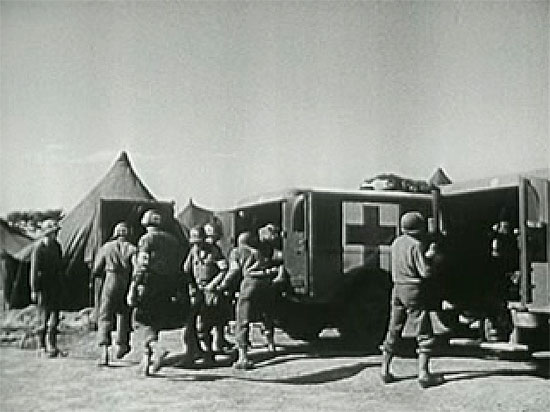
Members of the 15th Evacuation Hospital transport wounded troops from Dodge WC-54 Ambulances into Hospital Ward tents. Photograph taken in August, 1944.
Background:
The Medical Battalion was a Divisional medical unit developed to furnish medical support for the Infantry Division. Its primary mission was to organize and conduct the necessary evacuation and medical care for casualties of the Division. Because of the high mobility of the Division, the installations of the Medical Battalion had to be of a more temporary nature and possess increased readiness and ability to maintain contact with the different units of the Division. The Medical Battalion was thus charged with the evacuation of ALL casualties from the Infantry Battalion and Regimental Aid Stations. If for any reason, casualties could not be gathered at the Aid Stations, the Collecting Companies would remove casualties directly from the field.
The Medical Battalion was organized as a kind of ‘miniature’ medical organization in order to maintain the best operative coordination of all the existing facilities and to give flexibility to a possible expansion of the medical service when necessary. It always accompanied the Division in the field!
Organization:
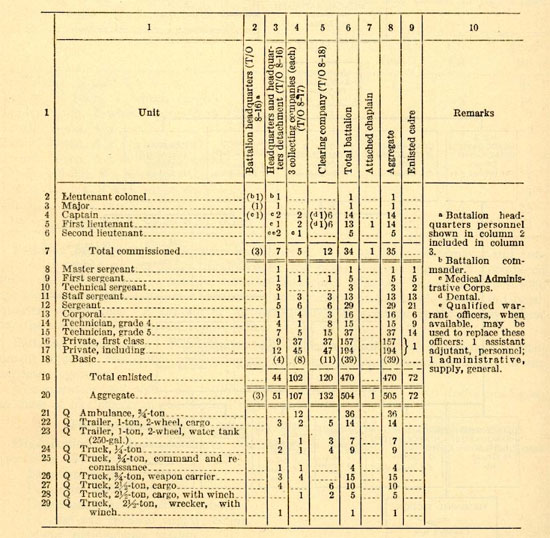
T/O 8-15, April 1, 1942, showing the organization of the Medical Battalion, Infantry Division.
Basic personnel figures (1942 data) : 34 Officers, 470 Enlisted Men, 1 attached Chaplain (of which 24 were Medical Officers, 8 were Medical Administrative Corps Officers, 2 were Dental Officers, and 470 were Enlisted Men – among which 67 Noncommissioned Officers, 52 Technicians, and 351 Privates First Class/Privates).
Vehicles used for transportation numbered (1942 data) : 36 x ¾-Ton Ambulances, 14 x 2-Wheel Cargo Trailers, 7 x 250-Gallon Water Tank Trailers, 9 x ¼-Ton Trucks, 4 x ¾-Ton Command & Reconnaissance Trucks, 3 x ¾-Ton Weapon Carriers, 6 x 1 ½-Ton 4×4 Cargo Trucks, and 16 x 2 ½-Ton 6×6 Cargo Trucks.
Organic Units:
The MEDICAL BATTALION, Infantry Division consisted of:
- 1 Battalion Headquarters
- 3 Collecting Companies (usually designated Company A, B, and C)
- 1 Clearing Company (usually designated Company D)

Diagramatical view of the organization of the Medical Battalion, Infantry Division.
Medical Battalion Headquarters:
Battalion Headquarters was an agency of command and control, consisting of the Commanding Officer (MC), the Executive Officer + Plans & Training Officer (XO + S-3, combined duty), and the Adjutant + Personnel Officer (i.e. MAC + S-1). Another Officer in charge of Intelligence (S-2) was later (1944) added and usually delegated as a Liaison Officer at Division Headquarters. The attached Chaplain was usually present at the Clearing Station. Enlisted personnel employed at Battalion Headquarters were members of the Headquarters & Headquarters Detachment. A Captain of the Hq & Hq Det was the Supply Officer for the Medical Battalion, and also the general Supply Officer of the Division. The CO usually was a Lieutenant Colonel.
Headquarters established the Medical Battalion’s Command Post! This was to be located in vicinity of the Clearing Station, which was the focal point of the Division medical support. Here were located the offices of the Medical Battalion CO and his staff, and the Message Center. A telephone line generally connected the Medical Battalion CP with the Division CP.
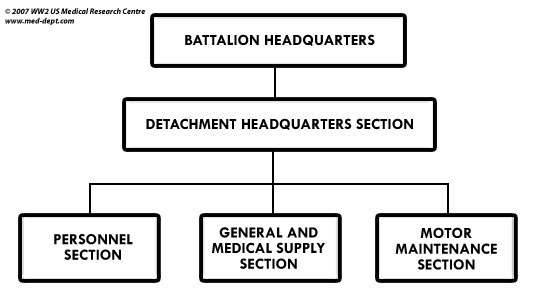
Illustration showing the organization of the Medical Battalion Headquarters and Headquarters Detachment.
Headquarters and Headquarters Detachment, Medical Battalion:
The normal functions of the Headquarters & Headquarters Detachment was the daily operation of activities necessary for the complete administration and maintenance of the Medical Battalion through such services as supply – mess – and clerical duty. It further operated the Division’s medical distributing point. The Headquarters Detachment normally set up its installations in vicinity of the Clearing Station and the Medical Battalion CP. By centralizing Battalion Headquarters and the Headquarters Detachment close to the Clearing Station, contact was always rapidly maintained with Collecting Companies by means of Ambulance-borne messages. By dispersing (most important) the transportation equipment and personnel of these installations, there was little likelihood of them being involved in enemy air attacks.
Personnel, exclusive of Battalion Headquarters, usually consisted (1942 data) of : 1 Captain (MAC), 1 First Lieutenant, 2 Second Lieutenants, and 44 Enlisted Men. The total number of available vehicles was 15.
Battalion Headquarters Section: consisted (1942 data) of : 3 Officers and 8 Enlisted Men.
The rest of the Headquarters organization included :
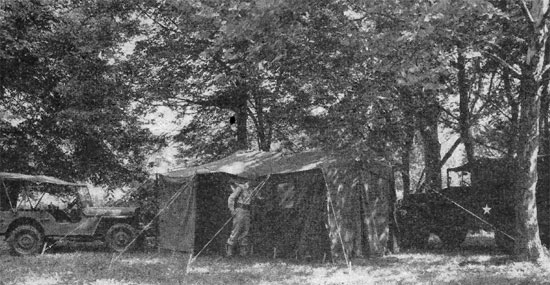
View of a Medical Battalion Command Post
Detachment Headquarters Section: consisted (1942 data) of : 1 Officer and 16 Enlisted Men. The Officer in command was usually a Captain. The Officer in command was later made responsible for Battalion supplies, designated S-4.
Personnel Section: consisted (1942 data) of : 1 Officer and 4 Enlisted Men. The Officer in charge, i.e. a Second Lieutenant was assisted by Personnel Clerks. This particular Section operated under supervision of the S-1 (Adjutant).
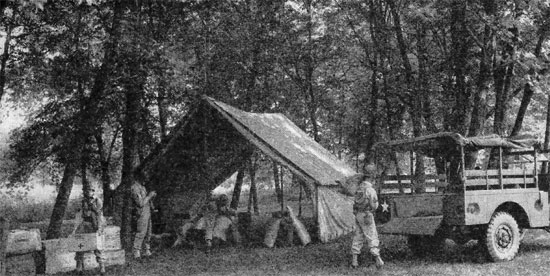
Illustration showing Supply Section distributing Medical and General Supplies to the Medical Battalion …
General and Medical Supply Section: consisted (1942 data) of : 1 Officer and 8 Enlisted Men. The Officer was either a Second Lieutenant (MAC) or a qualified Warrant Officer. This section operated under supervision of the S-4 (Supply Officer).
Motor Maintenance Section: consisted (1942 data) of : 1 Officer and 8 Enlisted Men. The Officer in charge was a First Lieutenant (MAC). This Section also operated under the S-4.
The COLLECTING COMPANY, Medical Battalion, Infantry Division:
The Medical Battalion had three (3) Collecting Companies, each identical in organization, transportation, and equipment.

Diagram showing the organization of a Collecting Company.
Collecting Companies were the forward echelon of the Division Medical Service. They were the connecting links in the chain of evacuation between Infantry Aid Stations and Division Clearing Stations. Their mission was to:
- Remove evacuees from Infantry Regiment Aid Stations to Collecting Stations
- Prepare evacuees at the Collecting Stations for further evacuation
- Transport evacuees by Ambulance from Collecting Stations to Division Clearing Stations
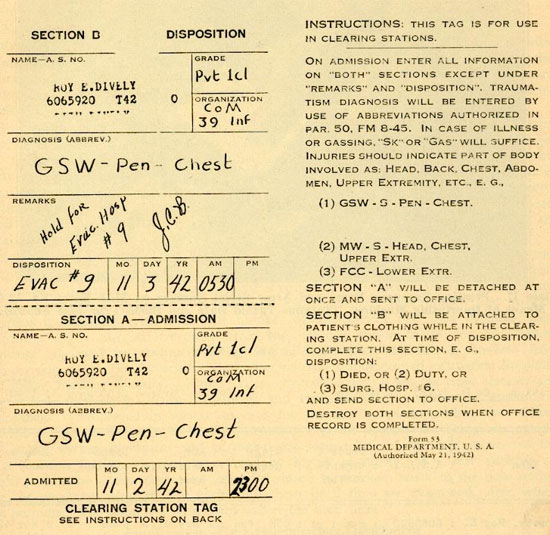
Method showing how to fill out a Clearing Station Tag, there are two different parts. Obverse side: Section A – Admission and Section B – Disposition; Reverse side: Instructions. This Tag is the early version M.D. Form 53, authorized May 21, 1942 (later superseded by DA Form 8-29 authorized July 12, 1944). It is important to note that the evacuee’s name and ASN are indicated on the Tag by means of an imprinting machine (Addressograph M70)
The major functions of the Collecting Companies were fourfold:
- Contact > to establish and maintain contact with the Medical Detachments of combat troops (in the present case, the Regimental Medical Detachment – Infantry Rifle Regiment)
- Treat > to establish and operate a Collecting Station, administering the treatment necessary to return minor casualties to their units, or to prepare more seriously injured casualties for further evacuation to the rear
- Evacuate > to relieve the Medical Detachments of casualties, moving these to the Clearing Station, or returning them to duty
- Transport > to transport casualties to the Clearing Station
Each of the three (3) Collecting Companies was responsible for the collection of all casualties from Aid Stations of the Division, the temporary treatment of these casualties, and their evacuation to the Clearing Station. The Collecting Companies provided medical support for the respective Infantry Regiments. When Standard Operative Procedures (SOP) were in effect, ONE Collecting Company usually accompanied the Regimental Combat Team (RCT). Occasionally an entire Collecting Company would not immediately accompany a combat team to position for battle. Some Collecting Company personnel with Ambulances and/or other transportation could remain behind with the Medical Battalion until such time as they were required in the operation of their Company. Such parts as remained behind constituted a kind of Company reserve, which was temporarily under command of the Medical Battalion CO until called for by the Collecting Company commander. Ambulances and personnel were meanwhile used for short missions, such as for evacuating units on call. Only the Collecting Companies had Ambulances!
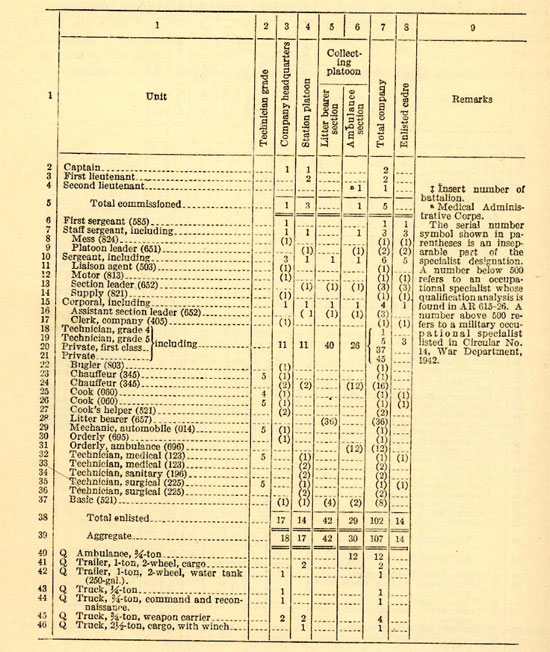
T/O 8-17, April 1, 1942, showing the organization of the Collecting Company, Medical Battalion, Infantry Division.
Basic personnel distribution was as follows (1942 data) : 2 Captains, 2 First Lieutenants, 1 Second Lieutenant (MAC), 14 Noncommissioned Officers, 6 Technicians, and 82 Privates First class/Privates.
Vehicles for transportation consisted (1942 data) of : 12 x ¾-Ton Ambulances, 2 x 1-Ton Cargo Trailers, 1 x 250-Gallon Water Tank Trailer, 1 x ¼-Ton Truck, 1 x ¾-Ton Command & Reconnaissance Truck, 2 x 1 ½-Ton Cargo Trucks, and 1 x 2 ½-Ton Cargo Truck.
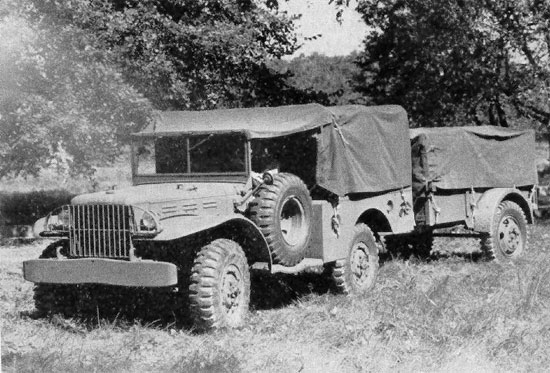
Illustration showing some of the means of transportation used by a Collecting Company . A 3/4-Ton Weapon Carrier with 1-Ton Cargo Trailer.
Company Headquarters:
The Collecting Company Headquarters consisted of 1 Captain and 17 Enlisted Men. The Headquarters was an administrative as well as a tactical organization. It provided for the control, administration, supply and mess of the individual Collecting Company.
Collecting Station Platoon:
The Station Platoon established and operated a Collecting Station for the emergency treatment of casualties being evacuated from the battlefield to the Clearing Station. The Collecting Station itself was set up in several Departments; all casualties brought in from the field passed through the Receiving Department & Property Exchange. Depending on the severity and nature of their injuries, casualties were treated either at the Seriously Wounded or Slightly Wounded Departments. Gas Casualties, if any, were treated at some distance from other casualties in order to prevent possible contamination. After treatment, the wounded requiring further evacuation were sent to the Forwarding & Property Exchange Department, where they were then loaded into Ambulances, while slightly wounded, fit to return to duty, were directed back to their units.
The Station Platoon consisted (1942 data) of 1 Captain, 2 First Lieutenants (both Medical Officers), and 14 Enlisted personnel. For functional purposes the Platoon was divided into a ‘Liaison Section’ and a ‘Collecting Station Section’. Since it was imperative for the Collecting Company to establish and maintain liaison with the aid Stations, a Liaison Section was usually created – T/O do not however prescribe such specific function – so it had to be improvised from well-trained EM, there were normally 4 liaison agents under command of a Sergeant (who usually operated the Message Center as well).
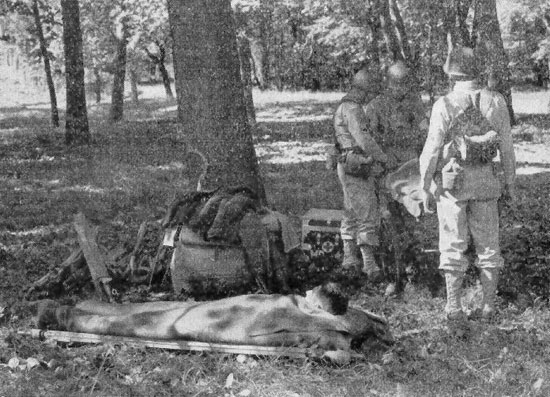
Receiving Department of a Collecting Station in the field
Collecting Platoon:
The Collecting Platoon consisted (1942 data) of 1 Officer (i.e. Second Lieutenant MAC), and 71 Enlisted Men. For functional reasons it was divided into a ‘Litter Bearer Section’ and an ‘Ambulance Section’. It is important to note the subsequent organization of these subsections; for instance, the ‘Litter Bearer Section’ consisted of 1 Sergeant, 1 Corporal, and 40 other Enlisted Men. The Section was subdivided into two small separate groups providing 4 Litter Squads each, it should be noted, that no transportation was provided as an organic part of the Litter Section – while the ‘Ambulance Section’ was commanded by 1 Second Lieutenant (MAC), 1 Staff Sergeant, 1 Sergeant, 1 Corporal, and 26 other EM. The Ambulance Section operated 12 x ¾-Ton Ambulances which represented its organic means of transportation (usually subdivided into two subsections of 2 Ambulance vehicles each).
The primary duty of the Litter Bearer Section was to evacuate casualties from the Aid Stations to the Collecting Stations. When unit Medical Sections were forced to move quickly in order to maintain medical support of units to which they were attached, Litter Bearers would have to clear the battlefield of wounded in the areas abandoned by the Medical Sections. Litter Relay Posts were therefore established with the aim to shorten the distance of the carry and ease the work of the Bearers. The wounded soldier was first carried by Hand Litter to a point on a road or trail, designated Litter Relay Post. Here, the casualty was transferred to a Wheeled Litter, and the Litter Squad then returned to the Aid Station to pick up another casualty. In the meantime the first casualty was taken to the Collecting Station. After delivering the patient, the Wheeled Litter men returned to the Relay Post for another casualty.
The Ambulance Section operated Ambulances which were driven by a Light Truck Driver, assisted by an Orderly. Casualties were ordinarily evacuated by Ambulances from the Collecting Station to the Clearing Station. The vehicles were often used for various missions, picking up casualties when the unit was on the march, either from Collecting Posts or directly from the marching columns, and evacuating them to the Clearing Station. They could also transport sick and injured personnel from camp or bivouac dispensaries to Clearing Stations. Furthermore they provided extra service transporting Litter Bearer Platoons to assembly areas, delivering medical supplies forward, carrying messages to other areas, and administering emergency treatment of casualties during evacuation…
The CLEARING COMPANY, Medical Battalion, Infantry Division:
The Clearing Company of the Medical Battalion operated Clearing Stations as necessary for the sorting and treatment of patients evacuated by the Collecting Companies. Patients were prepared at the Clearing Stations for further evacuation to the rear.
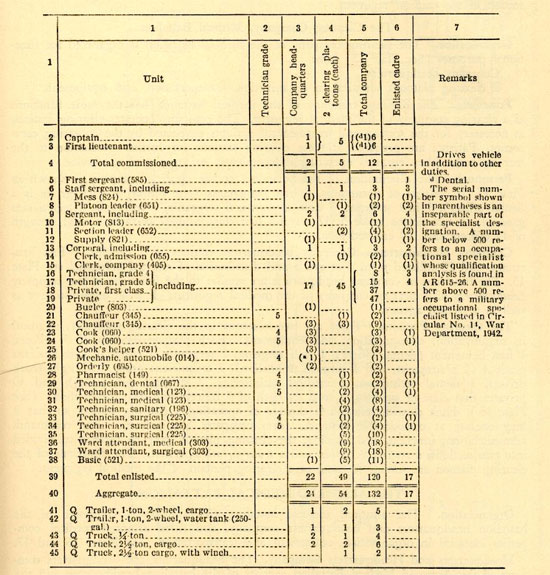
T/O 8-18, April 1, 1942, showing the organization of the Clearing Company, Medical Battalion, Infantry Division.
Primary functions of the Clearing Company included:
- Reception > receiving casualties brought into the Clearing Station by Ambulance of the Collecting Companies
- Triage > sorting of casualties according to the nature and severity of their injuries
- Treatment > administering appropriate treatment to save lives, reduce suffering, and prevent permanent disability
- Care and Shelter > providing temporary care and shelter of casualties until their physical condition permitted further evacuation
- Slight Injured > returning slightly wounded casualties to duty with their units
- Records > preparing appropriate medical records for the patients
- Dispensary > operating and running a Dispensary for treatment of personnel of the Medical Battalion when the Division was not engaged in combat
- Guard > performing Interior Guard Duty for the Medical Battalion, sharing this duty with the Collecting Companies
The distribution of personnel was (1942 data) as follows : 6 Captains, 6 First Lieutenants, 13 Noncommissioned Officers, 23 Technicians, and 84 other Enlisted Men.
The Clearing Company was further subdivided into 1 Company Headquarters and 2 Clearing Platoons.
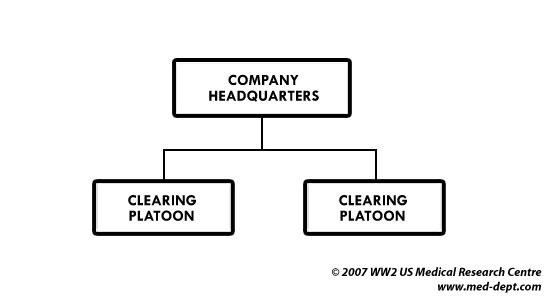
Organization of the Clearing Company, showing the 2 Clearing Platoons..
Company Headquarters:
The Company Headquarters was organized to perform the functions of command, administration, mess, supply, and motor maintenance. Company Headquarters established their Command Post at the Clearing Station. Supply Sergeant, Motor Sergeant, Mechanics, Bugler, Truck Drivers, and basic medical personnel, completed the Headquarters and remained with the CP. Headquarters did not operate their own mess but messed with the Clearing Company. When each Clearing Platoon established a separate Clearing Station, the CP simply remained at one of them, while the remainder of the Company Headquarters, such as supply and mess personnel, were divided between them.
The Clearing Company consisted (1942 data) of 1 Captain, 1 First Lieutenant, and 22 Enlisted personnel. The Headquarters operated an administrative as well as a tactical agency.
Vehicles included 1 x 1-Ton Cargo Trailer, 1 x 250-Gallon Water Tank Trailer, 2 x ¼-Ton Trucks, 2 x 2 ½-Ton Cargo Trucks.
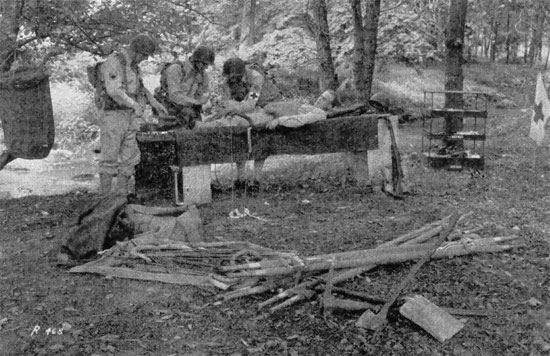
View of Receiving Department of a Clearing Station, where Litter Squads are in operation, either unloading Ambulances or removing patients from the Department
Clearing Platoon:
The Clearing Platoon consisted of Medical and Dental Officers, assisted by a fairly large number of Technicians. It operated a Clearing Station which was the last (second echelon) element in the Division medical service. The Station was generally set up in tents or in existent suitable buildings, and was arranged into Departments for administration and treatment of casualties. The installation consisted of a Clearing Station Office, a Receiving Department, with different sections for either Seriously Wounded or Slightly Wounded casualties, a Shock Section, an Operating Section, a Dental Department, a Gas Department (if necessary), extra Wards, a Dispensary (for Medical Battalion personnel, when not in combat), a Laboratory Section, a Supply & Storage Department, a Mess Section, a Forwarding Department, and a Morgue.
There were 2 Clearing Platoons in the Clearing Company, which were identical in organization, transportation and equipment. Each Platoon was capable of operating a Clearing Station, so that it could operate at considerable distances from Company Headquarters. The functions of the Clearing Platoon were largely technical, of a professional nature, so only a small amount of administrative work was necessary.
For command, administration, function, and training, each Clearing Platoon could be further subdivided into 2 separate Sections, a ‘Technical Section’ and a ‘Transportation Section’.
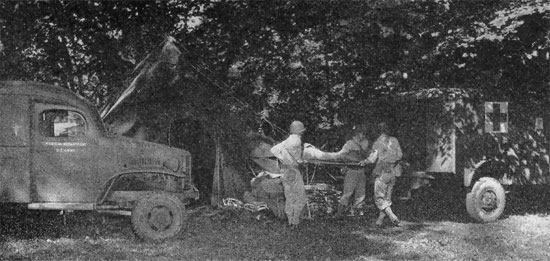
View of Army Ambulances evacuating casualties from a Clearing Station …
Normally one of the 2 Clearing Platoons remained as a reserve in vicinity of the Clearing Station. It could then relieve or reinforce the Clearing Station in operation, or it could be dispatched forward or rearward to establish another Clearing Station for the care of casualties occurring from major fluctuations of the frontline. Platoons of the Clearing Company were to be prepared to reinforce each other in emergencies, or leapfrog each other, according to the number of casualties requiring treatment, and the progress of the combat troops.
Each Clearing Platoon consisted (1942 data) of 5 Officers and 49 Enlisted Men.
Vehicles included 2 x 1-Ton Cargo Trailers, 1 x 250-Gallon Water Tank Trailer, 1 x ¼-Ton Truck, 3 x 2 ½-Ton Cargo Trucks.
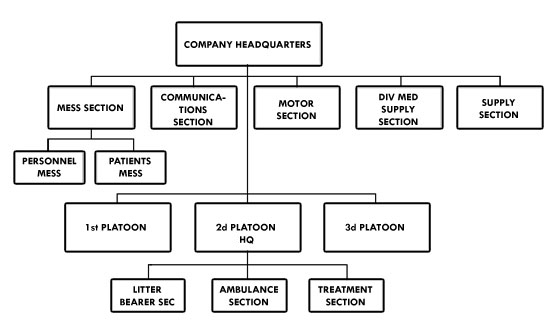
Ilustration showing the organization of the Airborne Medical Company.
Remark:
Frequently during heavy engagements, a Surgical Hospital moved to the vicinity of the Clearing Station to take over cases requiring extra surgical treatment. The advantage was that a Surgical Hospital was equipped with mobile operating rooms and necessary auxiliary equipment to perform major surgical operations. It also had a number of Ambulances in order to evacuate cases requiring urgent surgery from the Clearing Station to its own installations. For administrative purposes, it should be noted that patients evacuated for treatment by a Surgical Hospital were considered removed from the Division, as were those evacuated by higher echelon Ambulances to Evacuation Hospitals.

Picture showing the Seriously Wounded Department, Shock Section, of a Clearing Station
Notes:
Needless to add that similar organizations, like the Army Medical Battalions, existed for other branches of the U.S. Military. The functional organization of the Cavalry Division included a Medical Squadron, the (early) Motorized Division had a Motorized Medical Battalion, the Armored Division had an Armored Medical Battalion, the Mountain Division a Mountain Medical Battalion, the Engineer Amphibian Brigade (later ESB) an Engineer Amphibian Medical Battalion, and the Airborne Division an Airborne Medical Company.
For those readers who are interested, here follow some incomplete data related to above organizations:
Medical Battalion, Infantry Division, T/O 8-15, April 1, 1942– 35 Commissioned Officers & 470 Enlisted Men + 101 Vehicles and Trailers.
Medical Battalion, Infantry Division, T/O 8-15, July 15, 1943– 35 Commissioned Officers, 2 Warrant Officers & 429 Enlisted Men + 90 Vehicles and Trailers.
Medical Battalion, Infantry Division, T/O 8-15, July 3, 1944– 35 Commissioned Officers, 2 Warrant Officers & 407 Enlisted Men + 90 Vehicles and Trailers.
Motorized Medical Battalion, Motorized Division, T/O 8-65, C-1, July 31, 1942– 36 Commissioned Officers & 484 Enlisted Men + 100 Vehicles and Trailers.
Armored Medical Battalion, Armored Division, T/O 8-75, March 1, 1942– 43 Commissioned Officers, 3 Warrant Officers & 456 Enlisted Men + 130 Vehicles and Trailers.
Armored Medical Battalion, Armored Division, T/O & E 8-75, November 21, 1944– 33 Commissioned Officers, 2 Warrant Officers & 365 Enlisted Men + 105 Vehicles and Trailers.
Mountain Medical Battalion, Mountain Division, T/O 8-135, April 1, 1942– 47 Commissioned Officers & 543 Enlisted Men + 69 Vehicles and Trailers + 120 Animals (Horses & Mules).
Airborne Medical Company, Airborne Division, T/O 8-37, September 5, 1942 – 20 Commissioned Officers & 195 Enlisted Men + 45 Vehicles and Trailers.
Airborne Medical Company, Airborne Division, T/O & E 8-37T, December 16, 1944– 27 Commissioned Officers & 273 Enlisted Men + 65 Vehicles and Trailers.
